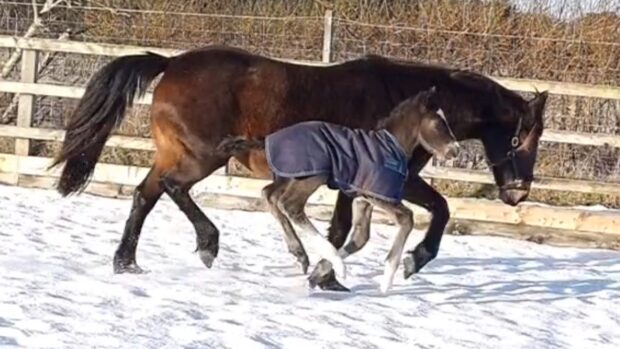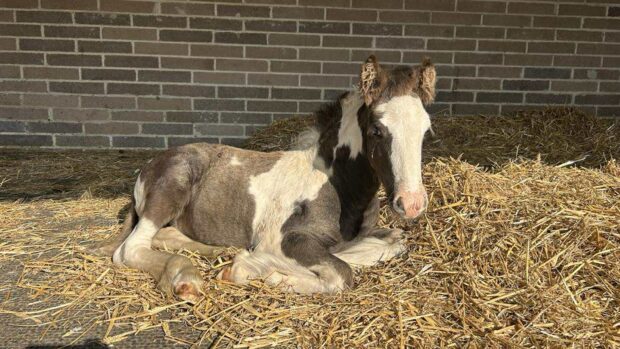Seeing a new equine life coming into the world is an uplifting experience, but foaling in horses – particularly for inexperienced horse breeders – can be mixed with anxiety about what to expect and the chance that something could go wrong. Being well prepared, with essential foaling supplies restocked and your vet’s details on hand, is key to peace of mind.
Foaling in horses: be prepared
Unlike women, mares have a relatively flexible delivery date, and sometimes a foal will arrive weeks earlier or later than anticipated. Therefore it makes sense to be prepared well in advance, but also plan for the unlikely, but still possible, situation where the mare does not give birth until weeks after you had expected her to. This inevitably seems to happen to the one-mare breeder who plans time off work to sit up with their mare and then finds they are still waiting weeks later.
If your mare is going to stud to foal, then ideally she should move about six weeks before she is due, both to allow her time to settle and also to build up some immunity to any disease-producing organisms in the new environment. This should be adequate time for the mare to develop protective antibodies that she will pass to her foal in her first milk, called colostrum.
At least one month before foaling — an average gestation period of 342 days from the last date of covering can be used — your mare should have a flu and tetanus vaccination. This allows some immunity to be passed to the foal, giving them protection for the first few months of life.

A Caslick procedure is designed to help prevent infection of the reproductive tract.
If your mare has had a Caslick procedure (the surgical closing of the upper part of the vulva to reduce the risk of infection), make an appointment with your vet at least three weeks before the due date, to remove it— this is essential to prevent the mare from tearing and to allow easy exit of the foal. If you aren’t sure if your mare has a Caslick, then ask your vet to examine her at least three weeks before her due date so that appropriate action can be taken. If you want to use an internal foal alarm, your vet could insert this at the same time.
It is sensible to do regular faecal worm egg counts throughout the mare’s pregnancy to ensure she remains relatively worm-free. Similarly it is wise to remove droppings from pasture to minimise worm infestations. Some people advise treating with a dewormer in the latter stages of pregnancy, however if you have been fastidious with your parasite control beforehand this may not be necessary. Always check the literature that comes with the wormer to establish that it is safe for use with pregnant mares and/or speak to your vet for advice. Vets recommend doing worm egg counts to monitor worm burden levels before treatment.
Where is best for foaling in horses to take place?
If you are going to have your mare foal at home, consider whether you have a suitable stable or whether the mare would be better foaling outside. Most professional breeders will foal their mares in a large foaling box, but if you decide to foal your mare outside it should be in a small paddock so that the mare cannot take herself too far away – she will normally go to the most remote and quiet part of the field. There also needs to be a reliable means of artificial light in case of an emergency, as things can and do go wrong — and most foals are born after dark when it is quiet and peaceful.

Any paddock should be free of obstacles and have secure fencing: post and rail is best, with the bottom rail close enough to the ground to prevent a foal rolling under it and, inadvertently, getting separated from its mother. And, of course, these safeguards also apply for the field you intend to use for your mare and foal after the birth.
A foaling box must be larger in size than a standard stable (4.5 metres by 4.5 metres is recommended, depending on the size of the mare) and preferably square in shape to allow plenty of room around the mare when she lies down to foal. It should be free of sharp or projecting objects.
A clean straw bed is typically the bedding of choice for foaling boxes. It helps to absorb birthing fluids, provides a soft landing for wobbly foals, and is less hazardous if the foal tries to eat it.
The foaling kit
Experienced breeder Sara Longworth of Waverley Stud in Warwickshire recommends setting up your foaling kit in a large plastic container with items that will be required immediately after birth, plus some that could be needed in case of emergency.
Her kit contains:
- phone numbers for the vet on the lid of the box (also save the number in your mobile phone)
- a plentiful supply of sterile gloves for washing the mare and handling the placenta
- scissors for cutting umbilical tape or tail wrap; or more seriously, in case of an emergency, for dealing with a red bag birth (where the placenta would need to be cut open), or, again in rare cases, for the need to cut the umbilical cord
- umbilical tape or clamp, in case the umbilical cord needs tying off immediately after foaling
- antiseptic spray or chlorhexidine wash to disinfect the umbilical stump and reduce possibility of bacterial infection
- towels, to dry off and stimulate breathing in the newborn foal
- thermometer for mare and newborn foal
- whole foal colostrum in case the mare doesn’t have any or does not produce enough, although this is rarely easily available. This is usually kept frozen until required.
- foal milk replacer in case the worst happens and the mare is lost
- plastic bottle and rubber teat for feeding a foal
- large container for milking the mare (in case the foal takes a long time to stand and suckle)
- enema (gentle sodium phosphate type) to administer to a newborn foal in case of meconium (first dropping) impaction
- If you don’t have good artificial light in the stable and in the yard, you will also need a strong torch or head light
- Some professional breeders may have a canister of oxygen with nose cone, in case there is an emergency with the foal, however it is far better to get professional help if needed
In a covered bucket, alongside the foaling kit, Sara also keeps mild liquid soap for washing the udder and genital area of the mare prior to foaling, and an extra long tail bandage to keep the mare’s tail hair out of the way throughout proceedings. Vets advise that both the mare and the foaling area need to be kept as clean as possible to reduce the risk of infection for the newborn foal, especially as it nuzzles the mare as it attempts to nurse. A head collar and lead rope always hang outside the stable door.
Signs of foaling in horses
During the last few weeks running up to foaling in horses, your mare will start to “bag up” – this means her udder increases in size. Once the udder remains full all day, and the teats enlarge and start to point out to the side rather than straight down, foaling is getting close and the mare should be monitored carefully.
The muscles around the mare’s pelvis will start to relax a few weeks before she is due, and hollowed areas either side of the top of tail may be seen. In the last couple of days before foaling, the mare’s vulva will also swell and relax.
“Waxing up”, when beads of colostrum showing at the end of mare’s teats, may occur 12 to 36 hours ahead of foaling, and is considered a strong indication that the mare will foal soon. However, this can differ between mares – some may wax earlier, while others won’t at all. If the mare starts running milk, she will be losing the important colostrum that contains vital antibodies to protect her newborn foal from disease. In this situation the milk should be collected and frozen, so it can be fed to the foal after birth, or an alternative source of colostrum must be available.
Not all mares show these signs – some will give you no warning signs whatsoever.
The stages of labour
As the mare moves into the early stages of labour, she may show general signs of discomfort that can be confused with colic, such as restlessness, kicking at the belly, looking at the flanks, and generally seeming irritable or anxious. If combined with sweating on her neck and flanks, and she continues to drink, urinate and pass droppings, this is likely to be the result of her body preparing for the birth, rather than colic. However, the actual delivery may still be some hours away. This may be interspersed with periods where the mare acts normally.
The second stage of the mare giving birth is very rapid, typically lasting less than 20 mins. This begins when the mare’s waters burst and a large quantity of pale yellow fluid will be released. After 5-10mins a white membrane called the amnion will appear, along with the front feet, typically one slightly before the other. If the mare has not already laid down, she will likely do so at this stage. She will continue to strain as the foal’s muzzle and then shoulders are passed, followed by the foal’s hips.

Once the hips are out of the birth canal, the mare may rest with the foal’s hind legs remaining inside her. This is not a cause for alarm and the mare should not be disturbed unless the birthing sack is obstructing the foal’s nostrils. At this stage the placenta is still providing blood to the foal. The umbilical cord breaks when the mare stands or the foal gets to its feet. The stump of the umbilical cord will need dressing to avoid infection.

The third stage of foaling in horses is the passing of the placenta – this is typically expelled with an hour of the foal’s birth. If the mare has got to her feet after giving birth, she may lay back down for this stage and show colic-like signs. If the placenta has not been delivered within three hours you should call your vet as a retained placenta is potentially life-threatening for the mare, particularly in heavier breeds of horse. Once it has been expelled, it should be carefully examined to ensure there are no tears or risk of any tissue having been left inside the mare. If you think this might be the case, then you should contact your vet.

Most foals are on their feet within an hour of being born and should be feeding from their dam within two hours. It is important to ensure that the foal gains sufficient colostrum in the first few hours as this provides them with important protection against infection. If the foal is not standing or feeding within two to three hours of arrival, then you should seek veterinary advice.
Foaling problems
Complications can arise during or after foaling in horses, as Sarah Stoneham MRCVS explains. Common problems include:
Dystocia: this is defined as a difficult birth that requires assistance. The most common problem is an abnormal presentation where the foal is in the incorrect position for a straightforward delivery. This is often associated with a deformity of the foal such as carpal contracture, a condition that prevents the foal from straightening its front legs. As time is of the essence, it is important to contact your vet at an early stage if things don’t appear to be progressing normally. You can then be given advice over the phone about what to do before the vet arrives. If the vet is unable to correct the problem promptly, emergency admission to a clinic may follow — either for a controlled delivery under general anaesthesia or a caesarean section. For this reason, always have horse transport ready to go if you have a mare due to foal.
Red bag: another name for premature placental separation, a red bag delivery occurs when the placenta fails to rupture over the foal’s feet as they pass through the birth canal. A red, velvety sac then appears through the vulval lips. This is a real emergency that requires prompt action to save the foal. Call your vet immediately and describe the problem, so you can be talked through the process of rupturing the placenta manually. You will then need to deliver the foal and help it to breathe before the vet arrives, because if the placenta is not ruptured the foal will be unable to breathe.
Stillbirth: a normal foal will start “gasping respiration” and start to breathe immediately on delivery, and the amniotic sac should be cleared from its muzzle immediately. It should be struggling to sit up on its sternum within 5min. Sometimes, the foal is not breathing at all when it is born — a problem that can occur following an apparently normal foaling. If the foal is able to be revived, it will need to be resuscitated immediately if it is to stand any chance of survival. This means being on hand with the necessary knowledge and equipment. If the foal has any difficulties, call your vet without delay for further health checks. It is really important that your foal stands and suckles, ideally within a couple of hours after birth – the sooner the better – if there are any concerns, call your vet.
Post-foaling haemorrhage: this potentially life-threatening condition can occur in the hours after foaling. The mare will be bleeding from one of the large internal arteries that supply blood to the uterus. Initially, the haemorrhage will be contained within the ligaments around the uterus. If the bleeding continues, however, and ruptures the ligaments, the mare is likely to haemorrhage into the abdominal cavity, with fatal consequences. If haemorrhage has occurred, the mare may show colicky signs such as sweating and shaking, and her mucous membranes will rapidly become pale. Keep her as quiet and comfortable as possible until your vet arrives. The condition is more common in older mares, although it can occur at any age.
Other problems, such as post-foaling colic, can occur, so keep a close watch on both mare and foal after delivery.

Most foaling in horses goes smoothly with the mare not requiring any help, but it is always wise to be prepared as the organising and homework you do now will pay off handsomely when the time comes.
- With thanks to Sara Longworth of Waverley Stud in Warwickshire and Sarah Stoneham MRCVS for their contributions to this article
You may also be interested in…

How a squeeze can save a dummy foal’s life

Difficult foalings: foal presents upside down
Andrea Oakes talks to Kara Johnston MRCVS about how she dealt with the delivery of a foal that presented for

Difficult foalings: emergency caesarean in hospital

Difficult foalings: when life-giving colostrum turns toxic

How one top mare fought for her life after foaling
Find out how top mare Rachel Alexandra battled back from near-death after foaling complications

Difficult foalings: lost the mare but saved the foal





